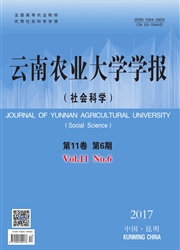

 中文摘要:
中文摘要:
就应用统计学方法处理生牛奶卫生检验数据的优势和细节进行了阐述。在2006年全年的观测期内,选择贮罐生牛奶的好氧细菌总数(total aerobic bacterial count,TABC)作为评价生牛奶卫生质量的重要指标进行检测和分析。首先,将原始数据进行基本的统计学整理,获取的初步信息包括时间序列图,柱状图,以及每个月数据的平均值,方差,中位数和变动范围等。其次,使用单因素方差分析和Tukey’s多重比较对各个月数据之间的差异性进行分析。分析前数据经幂转换(幂指数为0.45)以满足正态分布的统计学要求。结果显示,在1-3月,4-5月,6-9月,10月,11-12月这5个时间段内,各组数据内部没有统计学上的显著性差异,因此将数据分别合并以便寻求更大范围内的规律。最后,引入质量分析和控制图来评估各阶段生牛奶TABC的水平和稳定性。并对异常原因进行判定。在因果关系鱼骨图的帮助下,质量发生异常的相关因素可以从人员,物料,设备,操作,检验和环境等几方面进行探讨。在TABC不得高于200000 cfu/mL的限制下,只有在实施乳品安全计划的10月份,生牛奶卫生质量高,生产稳定。而其他时期都不同程度出现质量波动不稳定以致“失控”的现象。因此有必要利用统计控制手段帮助查找原因,修正错误,改善条件,稳定生产。本研究结果表明恰当的统计学方法有助于检验者和管理者把握TABC数据的变化趋势,防患于未然,而不仅仅是做一个产品质量指标合格与否的判断。
 英文摘要:
英文摘要:
In this paper, the benefits and details of applying Statistics methods on managing of the testing data of bulk-collected raw milk are presented. During a year investigating period of 2006, the total aerobic bacterial count (TABC) of bulk-collected raw milk as an important hygiene quality characteristic were collected from a dairy factory lab and analyzed in retrospect. Firstly, the basic statistics (e. g. charts, mean, median, range) of the raw data were done preliminarily. Secondly, one-way ANOVA and Tukey's multiple comparison were used to determine the significant difference among the groups of treated data that were normalized by idemponent transformation ( λ = 0. 45). The comparing results showed that the difference of the data from the following periods were not statistically different respectively: [ January, March ], [ April, May], [ June-September], [ October] and [ November, December]. Then based on the 5 periods, the data no significant differences were merged to form 5 new groups for the next statistical control analysis. Finally, some control and quality charts for individuals were introduced to evaluate the TABC levels and stability of the bulk-collected raw milk, and to detect the presence of special causes. Under the upper limit TABC level of 200 000 cfu/mL, only in October when a dairy sanitation plan was practiced, the production of high-hygiene-quality raw milk was stable and effective. However, the raw milk quality during other periods showed a trend of "out-of-control". Possible factors affecting the quality, such as the material, the men (personnel), the methods, the measurements, the machine and the environment (5M1E) were also discussed through a cause-and-effect diagram. It is necessary to apply statistical control methods to help improving and stabilizing the process. It is concluded that appropriate statistics method would help inspectors and managers to establish a trend analysis of the TABC data, and not just make a list of a Pass/Fail classification for t
 同期刊论文项目
同期刊论文项目
 同项目期刊论文
同项目期刊论文
 Study of Starch Gelatinization in a Flow Field using Simultaneous Rheometric Data Collection and Mic
Study of Starch Gelatinization in a Flow Field using Simultaneous Rheometric Data Collection and Mic Comparative Study of Inactivation and Conformational Change of Lysozyme Induced by Pulsed Electric F
Comparative Study of Inactivation and Conformational Change of Lysozyme Induced by Pulsed Electric F Purification and Characterization of a Novel Fibrinolytic Enzyme from Bacillus sp. Nov. SK006 Isolat
Purification and Characterization of a Novel Fibrinolytic Enzyme from Bacillus sp. Nov. SK006 Isolat Effect of high pressure treatment on some physicochemical and functional properties of soy protein i
Effect of high pressure treatment on some physicochemical and functional properties of soy protein i Specific and rapid detection of foodborne Salmonella by loop-mediated isothermal amplification metho
Specific and rapid detection of foodborne Salmonella by loop-mediated isothermal amplification metho Analysis of genetic determinants involved in multi-resistance in clinical strains isolated from rena
Analysis of genetic determinants involved in multi-resistance in clinical strains isolated from rena Dehydration of concentrated Ganoderma lucidum extraction by combined microwave-vacuum and convention
Dehydration of concentrated Ganoderma lucidum extraction by combined microwave-vacuum and convention Unnoticed Spread of Class 1 Integrons in Gram-positive Clinical Strains Isolated in Guangzhou, China
Unnoticed Spread of Class 1 Integrons in Gram-positive Clinical Strains Isolated in Guangzhou, China New array of aacA4-catB3-dfrA1 gene cassettes and a none-ORF cassette from a class 1 integron-positi
New array of aacA4-catB3-dfrA1 gene cassettes and a none-ORF cassette from a class 1 integron-positi Study of thermal properties and heat-induced denaturation and aggregation of soy proteins by modulat
Study of thermal properties and heat-induced denaturation and aggregation of soy proteins by modulat Purification and Partial Characterization of Lactobacillus Species SK007 Lactate Dehydrogenase (LDH)
Purification and Partial Characterization of Lactobacillus Species SK007 Lactate Dehydrogenase (LDH) Effect of thermal pretreatment of raw soymilk on the gel strength and microstructure of tofu induced
Effect of thermal pretreatment of raw soymilk on the gel strength and microstructure of tofu induced Acetylated Starch-based Biodegradable Materials with Potential Biomedical Applications as Drug Deliv
Acetylated Starch-based Biodegradable Materials with Potential Biomedical Applications as Drug Deliv Distribution and characterization of integrons in various serogroups of Vibrio cholerae strains isol
Distribution and characterization of integrons in various serogroups of Vibrio cholerae strains isol Influence of transglutaminase-induced cross-linking on in vitro digestibility of soy protein isolate
Influence of transglutaminase-induced cross-linking on in vitro digestibility of soy protein isolate Purification and characterization of L-arabinose isomerase from Lactobacillus plantarum producing D-
Purification and characterization of L-arabinose isomerase from Lactobacillus plantarum producing D- Usefulness of Sau-PCR for molecular epidemiology of nosocomial outbreaks due to Burkholderia cepacia
Usefulness of Sau-PCR for molecular epidemiology of nosocomial outbreaks due to Burkholderia cepacia Effect of cross-linkage of POCI3 on invitrodigestibility and formation of enzyme resistant starch of
Effect of cross-linkage of POCI3 on invitrodigestibility and formation of enzyme resistant starch of Loop-mediated isothermal amplification method for rapid detection of the toxic dinofagellate Alexand
Loop-mediated isothermal amplification method for rapid detection of the toxic dinofagellate Alexand Effect of processing parameters on the properties of transglutaminase-treated soy protein isolate fi
Effect of processing parameters on the properties of transglutaminase-treated soy protein isolate fi Nosocomial infection caused by class 1 integron-carrying Staphylococcus aureus in a hospital in Sout
Nosocomial infection caused by class 1 integron-carrying Staphylococcus aureus in a hospital in Sout Effect of high-intensity pulsed electric fields on the activity, conformation and self-aggregation o
Effect of high-intensity pulsed electric fields on the activity, conformation and self-aggregation o 期刊信息
期刊信息
